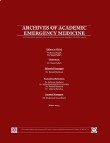Incidence and Risk Factors of Clinical Deterioration dur- ing Inter-Facility Transfer of Critically Ill Patients; a Co- hort Study
Critically ill and injured patients are at a higher risk of developing clinical deterioration during inter-facility transfers. This study aimed to determine the incidence rate and risk factors of clinical deterioration among critically ill patients during inter-facility transfers in Thailand.
The present cohort study was conducted in 22 referring hospitals and 7 receiving hospitals under the supervision of Ministry of Public Health, Thailand, between March 15 and December 31, 2018. The subjects were comprised of 839 critically ill patients aged 18 and over, 63 coordinator nurses in referral centers, and 312 referral team leaders. Data collected included pre-transfer risk score, clinical data of patient during transfer, characteristics of referral team leader, ambulance type, preparation time, time to definitive care, transfer distance, and National Early Warning Score (NEWS) (clin- ical deterioration). Multilevel mixed-effects regression analysis was performed.
The incidence rate of clinical deterioration was 28.69%. The most common types of clinical deterioration were hemodynamic instabil- ity, respiratory instability, and neurological alteration. Time between 31-45 minutes was significantly associated with clinical deterioration ( β 0.133, P value 0.027). The following illnesses were associated with higher proba- bility of clinical deterioration: body region injuries/head injury/burn/ingested poison ( β 0.670, P value 0.030), respiratory distress/convulsion ( β 0.919, P value 0.001), shock/ arrhythmias/chest pain/hemorrhage ( β 1.134, P value <0.001), comatose/alteration of consciousness/syncope ( β 1.343, P value <0.001), and post-cardiac arrest ( β 2.251, P value <0.001). Patients with unstable conditions ( β 1.689, P value 0.001) and pre-transfer risk score of 8 or higher ( β 0.625, P value 0.001) had a higher rate of deterioration. Transfer by non- emergency room (ER) nurses ( β 0.495, P value 0.008) and transportation in a mobile intensive care unit (ICU) were associated with a higher rate of deterioration ( β 0.848, P value 0.001).
The incidence of clinical deterioration during inter-facility transfer in Thailand was high. Illnesses involving circulatory, respiratory, and neurological systems, clinical instability, high pre-transfer risk score, transport time of 31-45 minutes, transportation by non-ER nurse, and mobile ICU were associated with a higher rate of clinical deterioration.
- حق عضویت دریافتی صرف حمایت از نشریات عضو و نگهداری، تکمیل و توسعه مگیران میشود.
- پرداخت حق اشتراک و دانلود مقالات اجازه بازنشر آن در سایر رسانههای چاپی و دیجیتال را به کاربر نمیدهد.


